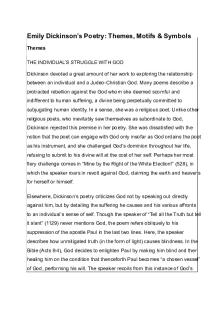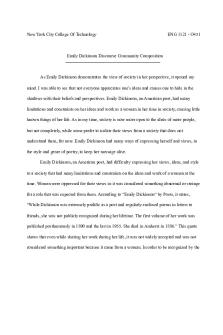Poetic Analysis of I like to see it lap the miles by Emily Dickinson PDF

| Title | Poetic Analysis of I like to see it lap the miles by Emily Dickinson |
|---|---|
| Course | english |
| Institution | Silver Creek High School (Colorado) |
| Pages | 1 |
| File Size | 34.1 KB |
| File Type | |
| Total Downloads | 9 |
| Total Views | 124 |
Summary
Paragraph Poetic Analysis of I like to see it lap the miles by Emily Dickinson, includes figurative language and repetition in its symbols in the poem...
Description
I like to see it lap the Miles by Emily Dickinson, published in 1891, establishes a 4-stanza poem centered around a living train. It is written as a breathing creature, such as in lines 2 and 3, “And lick the Valleys up - /And stop to feed itself at Tanks - .” Dickinson suggests the actions of this train mirrors that of a horse or other large animal. The entire poem rests on the figurative symbol of how the train travels between cities and moves just like an animal. She compares the train and the train station to a stable, “Then - prompter than a Star / Stop - docile and omnipotent / At it's own stable door - .” The last 3 lines signify how the travel of the train stops at each station, similar to a horse with the reference to a stable door. There is an emphasis on the audibility of the poem, allowing the reader to gain a greater understanding of the actions of the moving train as it travels from city to city. She uses keywords such as “hooting”, “neigh”, and “complaining,” all to give the train animal-like traits. Not only do those words set off each stanza, it is incredibly important to the perception of the poem, as the reader can not only visualize the rumbling and groaning engine of the train, but also audibly hear its whistle as it races through the town....
Similar Free PDFs

Emily Dickinson - notes
- 6 Pages

poesie di emily dickinson 1
- 1 Pages

Bend it Like Beckham
- 3 Pages

As you like it
- 96 Pages

Informe \"As you like it\"
- 1 Pages
Popular Institutions
- Tinajero National High School - Annex
- Politeknik Caltex Riau
- Yokohama City University
- SGT University
- University of Al-Qadisiyah
- Divine Word College of Vigan
- Techniek College Rotterdam
- Universidade de Santiago
- Universiti Teknologi MARA Cawangan Johor Kampus Pasir Gudang
- Poltekkes Kemenkes Yogyakarta
- Baguio City National High School
- Colegio san marcos
- preparatoria uno
- Centro de Bachillerato Tecnológico Industrial y de Servicios No. 107
- Dalian Maritime University
- Quang Trung Secondary School
- Colegio Tecnológico en Informática
- Corporación Regional de Educación Superior
- Grupo CEDVA
- Dar Al Uloom University
- Centro de Estudios Preuniversitarios de la Universidad Nacional de Ingeniería
- 上智大学
- Aakash International School, Nuna Majara
- San Felipe Neri Catholic School
- Kang Chiao International School - New Taipei City
- Misamis Occidental National High School
- Institución Educativa Escuela Normal Juan Ladrilleros
- Kolehiyo ng Pantukan
- Batanes State College
- Instituto Continental
- Sekolah Menengah Kejuruan Kesehatan Kaltara (Tarakan)
- Colegio de La Inmaculada Concepcion - Cebu










